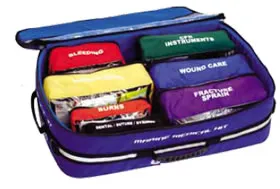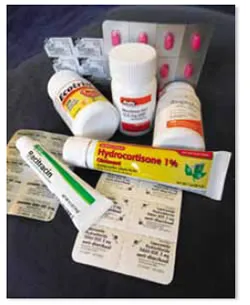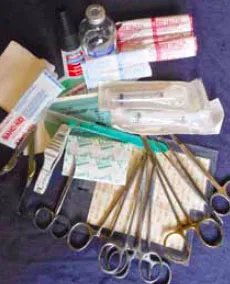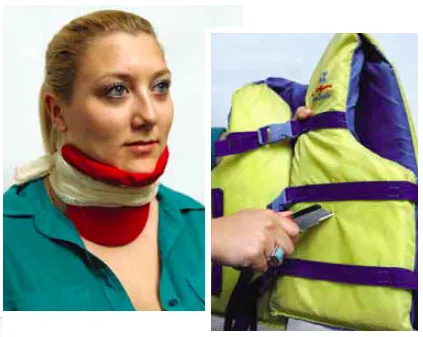
Sailors know the most about the things we use the most. We check our amp hours every day, our standing rigging frequently, our sails every time they’re up, the anchor shackle before settling in for the night. After all, these are the things that keep us comfortable and safe on a daily basis.
The corollary is that we know the least about the things we use the least. How often do we check the chain on the backup anchor, the lines on the drogue, the clew of the storm sail? After all, its human nature to not think about things we hope we never have to use.
First-aid kits fall into the hope-we-never-have-to-use-it category. Lucky sailors go an entire cruise or summer without even having to remember where it is. The rest of us dig it out from time to time, and then wonder why there’s so little in it or why there’s so much of stuff we’ve never used.
There are several companies that will solve this problem for us. They provide fully stocked first-aid kits with everything from band-aids to automatic defibrillators, packed in water-tight or water-resistant packaging designed to survive in a life raft. If you’re headed offshore, take along one of these kits and a satellite phone that can put you in touch with a remote telemedicine company (see PS April 2014 online), and you can be talked through virtually any on-board medical issue.
But most sailors are coastal cruisers, usually anchoring at night, often within a day or two of urgent medical care. For the majority of sailors, it is perfectly sensible to leave port with a first-aid kit that will fully resolve minor medical issues but will also manage the initial phases of a major medical emergency until you can get to shore.
Do-it-yourself (DIY) first-aid kits are hardly new. In a 1950 issue of Rudder, the long-gone monthly magazine for yachtsmen, a physician developed a list of items every boat should have aboard, leaning heavily toward the just-released wonder drug Benadryl, bicarbonate of soda, sulfa, and whiskey. But the list and accompanying advice also emphasized that sailors who could solve the daily problems of managing a boat had sufficient good sense to treat many medical problems as well.
For advice on a DIY first-aid kit, we turned to Fred Bagley, a retired general surgeon who doublehands a 38-foot sloop with his wife on Lake Huron and Lake Superior. In addition to occasionally dispensing medical advice to other sailors in remote anchorages, he has stapled his wife’s scalp after she got whacked by a bouncing boom (without local anesthesia, we might add) and sutured his own finger as his wife tied the knots.
These DIY first-aid kits do not have to be expensive, but they do require some cooperation from your family doctor and some careful shopping at your local pharmacy.
In compiling this do-it-yourself first-aid kit, several assumptions apply:
Barring mechanical breakdown or severe, adverse weather, the boat can get to land in 12 to 24 hours of steady sailing or motoring.
All crewmembers have brought adequate amounts of their own medications, know the side effects of those medications, and have relayed this information to the rest of the crew. (See the PS editorial in the April 2014 issue for an example of when the lack of this information proved quite critical.)
There is sufficient collective commonsense among the crew to distinguish minor from major medical issues.
The boat has functioning VHF or cell-phone coverage to ask for help locally from other boats. While your own crew might not include a doctor, in any anchorage with other boats, you often will find a physician, nurse, or EMT who would be glad to help out. While an ophthalmologist may not have seen a broken ankle since medical school, she probably still knows more than you do.
The boat has a comprehensible first-aid book. No matter how comprehensive the book is, its of little use if it doesn’t make sense to you. Perusing it prior to the trip would help too.
No boat can be prepared for every medical issue that might arise. If one of your crew has a fatal heart attack in the Gulf of Maine, there may be nothing anyone, anywhere can do to help him.

Lacerations
The most likely and scary medical situation you might encounter is a laceration. Blunt scalp wounds when the boom unexpectedly jibes over are often best closed immediately with staples. Simple, shallow lacerations can be closed with SteriStrips or super glue.
More complex wounds may require a local anesthetic, removal of damaged tissue, and suturing. This need not be as difficult as it seems; except for the squeamish part, any sailor who can mend a sail can sew up a wound well enough to meet the immediate emergency. A good first-aid book will have illustrations how to do this. You will need the cooperation of your family doctor to prescribe items like needles, syringes, and local anesthetic. There are several companies that sell sterile, single-use laceration kits for as little as $6, and others that sell more complex, reusable kits for up to $40.
Medications
You will have to explain to your family doctor why you want prescription medications for illnesses you don’t currently have, but your doctor will also be best able to determine whether these medications are compatible with any of your existing conditions or the medicines that treat them. And remember that if there are children aboard, the appropriateness and dosing of medications will be totally different.
We asked a primary care physician for advice about which antibiotics would treat the most common infections, those infections that are a nuisance but with a little luck do not require heading toward shore. For female urinary tract infections, he recommended nitrofurantoin (Macrodantin) and for male prostatitis, trimethoprim-sufamethoxazole (Bactrim). For severe ear infections or bronchitis with a cough, temperature, and lassitude suggesting pneumonia, keeping zithromycin (Z-pak) on board would be wise. Other antibiotics to have on board include good old-fashioned penicillin, in case redness appears immediately after closing up a laceration, and cephalexin (Keflex), in case the wound shows signs of infection several days later. Again, check with your physician to see if he agrees, and if you think you have to use one of these antibiotics, go to your first-aid book.
For that severe poison ivy covering your legs that wont respond to local control (hydrocortisone 1% available over the counter or betamethasone by prescription), having methylprednisolone (Medrol Dose Pak) on hand will let you sleep at night.
If you are venturing into tropical waters, you’ll want to bone up on the treatment of stings from poisonous marine life. Two good books are listed in the Resources list accompanying this article.
Narcotics should be obtained in just enough quantity to get you to shore with that broken ankle; 15 oxycodone/acetaminophen (Percocet) should be enough. The local emergency room will give you more once they’ve put you in a cast.
The expiration date of prescription medicines is rarely stamped on the bottle or tube but the information is available to your pharmacy. Ask them to supply medications that are good for at least two years, the usual factory stated longevity of antibiotics. Off the record, your pharmacist may tell you they are good for a lot longer.
Medical Supplies
National chain pharmacies will have most of the bandages, gauze, cold packs, and antiseptics you will require, but you may want to visit an independent pharmacy or medical specialty store for more esoteric items. For instance, one national chain we visited had vinyl gloves, but the medical supply store had a choice of vinyl or nitrile (although the cheapest and best variety of gloves was at our local Home Depot). Likewise, the chain pharmacy had just one size of SteriStrips, but the medical supply store had four sizes plus butterfly strips and cyanoacrylate skin closure spray. (Again, Home Depots super glue was cheaper.)
Over-The-Counter Medicines
Having a good supply of over-the-counter drugs can solve a lot of the nuisance medical problems encountered on boats. Topical 1% hydrocortisone and loratidine (Claritin) will manage most poison ivy; save the sleep-inducing diphenhydramine (Benadryl) for nighttime. Meclizine (Bonine) might help some of your queasy guests or even yourself on those first few days on the water. Ibuprofen (Motrin, Advil) and aspirin are musts, and some loperamide (Immodium) for diarrhea can come in handy as well.
Carrying/Storage Cases
For a carrying case to hold a DIY first-aid kit, we went to our local Home Depot and found a good selection of secure, moderately water-resistant toolboxes, costing $15 to $20. We liked the Craftsman models because of the secure latches and the red color. You might consider using the interior shelf for quickly needed minor things like band-aids or poison-ivy cream, reserving the lower compartment for the less commonly used items. We found it easiest to store all the material in see-through, sealable plastic bags of different sizes rather than dealing with boxes.
We also suggest putting a note pad in the case to record every time you use something up; when you stop at a marina during your cruise to get fuel or ice cream, ask directions to the nearest pharmacy to resupply.
Items Not On The List
Many things in sailing are compromises. A heavier displacement means easier motion but slower speed upwind; a deep fin keel boosts windward performance but limits gunkholing. So it is with first-aid kits. Decisions have to be made, and not everything can be carried.
The key to good wound management is time; the sooner the injury is repaired, the better. For that reason, items that are clean (gauze, instruments, etc.) are perfectly OK; sterility is only mandatory for things injected under the skin (e.g. needles, local anesthetics).
Dental emergencies are rare and tough to manage even for trained medical personnel. Pain medicines, even narcotics, may have to do until you can get to shore. Emergency tooth repair kits are available but will be excessive for most coastal cruisers.
Intravenous infusion equipment like IV catheters, tubing, and saline bags are so specialized that we doubt most crews could manage them without proper training, not to mention manage the medicines one would carry to put through the tubing.
Epinephrine injections for anaphylactic reactions can be lifesaving. Presumably a crew member with peanut or bee-sting allergies would have their own supply, so to carry EpiPens (which cost about $250 for pack of two) seems unnecessary.
Splints for fractured long bones are so varied in size that few boats could carry enough to treat all the potential fractures that might happen. We have little doubt that sailors who can splice frayed lines and jury rig broken rudders can’t figure out a way to splint a broken bone with what they have on board. The same applies to tourniquets.
Having blood-pressure cuffs on board makes sense if a crew member with hypertension uses it to monitor their own high blood pressure or if you want to invest in an automated one (about $40). But if you are contemplating the old-fashioned cuff using a stethoscope, you need to be well trained in how to interpret the sound of the pulse returning. Likewise, having a $75 stethoscope on board makes little sense unless you know how to use it.

Conclusion
First-aid kits can get expensive. The units from Adventure Medical Kits, the highly regarded kits we reviewed in the December 2008 issue and again in the April 2014 issue, run from $300 to $750. The DIY kit described here will run upward of $200, or about the cost of a good mainsheet block. Adding in all the prescription medications to either the commercial or the DIY kit could add another $250.
The advantage of the DIY kit is that you build it yourself to fit your cruising style and your first-aid skills, and the items can be refilled from any pharmacy. And with a little luck, just like your boats insurance policy, you will never need it.
VALUE GUIDE: DIY Medical Kit Contents
The number of each item you should pack will depend on the size of the crew and the length of the voyage. Everything here can be replenished at almost any pharmacy. Prices are the average of two different pharmacies (one national chain and one independent) and Home Depot, and they are rounded to the nearest half-dollar. Prices for antibiotics are for a full therapeutic course.
help stem the bleeding.
Commercially available laceration repair kits come in two basic groups: sterile single-use and non-sterile reusable. The former are less expensive with lower quality and fewer instruments; however, for the rare times that lacerations require suturing, they may be perfectly adequate. The kits do not come with a printed expiration date, but as long as the packaging is intact, the contents will stay sterile indefinitely. And yes, hold on to the instruments, because in a pinch they could be used again.
Moore Medical (www.mooremedical.com) has a variety of single-use suturing kits, ranging from $6 to $13; these would meet most basic suturing needs on board. However, the kit includes needles and a syringe, so it requires a doctor’s prescription, and in all their kits, suture material has to be ordered separately.
School Health (www.schoolhealth.com) sells a sterile, singleuse laceration tray that includes needles and syringes along with the suturing equipment for $15. According to their representative, a physician’s prescription is not required (unlike the Moore Medical kit); it also does not include sutures.
The more expensive reusable laceration kits have the obvious problem of cleaning before and after use. As indicated elsewhere however, the goal in wound closure is promptness, in which case “clean” trumps “sterile.” One should be cautious, however, in using an instrument on more than one crew member without sterilization or at the least very, very thorough cleaning. Oasis makes a variety of these reusable kits, ranging in price from $45 to $70; these have everything you might need to close a wound, including sutures and surgical staplers. They can be found on eBay.
Remember that none of the laceration repair kits available online or at your local medical supply house come with local anesthetic. That will require a physician’s prescription.
VALUE GUIDE: Laceration Kit Contents

If you reach for the onboard first-aid kit and find out there isn’t one, don’t panic during an emergency. Some out-of-the-box thinking will help put the needed medical tools in your hands.
The guiding rule to survival is to use what’s available and improvise.
- Battens make ideal arm and leg splints. A rolled magazine can become both a splint and temporary cast, particularly when fastened snuggly with duct tape.
- Popsicle sticks make good finger splints.
- A towel cut into a triangular shape is a sling.
- Rolled towels can substitute for the foam blocks used to secure a patient’s head to a long spine board before transfer to a stretcher and ambulance.
- A belt is a tourniquet, as is a cloth sail tie or piece of webbing, both far better than twine or thin-diameter line that might cut into the skin when tightened. Be careful not to stop blood circulation completely or for longer than necessary.
- An eye injury can be covered and protected with a paper cup. Duct tape can be used to keep the cup in place.
- A baseball cap, the top material collapsed against the inside of the front insignia panel, can serve as a rudimentary cervical collar when tucked upside down beneath the chin. It can be fastened with duct tape or tied with a piece of fabric.
- A sail, especially a clean one, provides a warm and comfortable wrap for patients suffering from hypothermia.
- Aluminum foil works wonders when trying to keep a patient warm. It also can be used as a bandage cover.
- Clear plastic wrap can cover a sucking chest wound. Tape it on three sides.
- A clear plastic bag can shroud an injured hand or foot.
- Fresh water sterilized by boiling can be used to flush wounds.
- A turkey baster makes a wonderful syringe for irrigating a laceration.
- Bunk sheets can be folded into compress bandages.
- Napkins can be cut into small wound dressings similar to gauze pads.
- A plastic credit card can be used to brush off a bee’s stinger or nettles.
- For sailors with emergency medical experience, a cockpit winch and a length of webbing can be carefully implemented as a mechanical traction device for femur fractures.
- Sanitary napkins like Kotex make for absorbent wound dressings, while tampons can be used on nosebleeds or injuries with minor blood flow.
- Tea bags will sop up blood in a mouth injury.
- Fresh oranges can provide vitamin C. No glucose on board? Orange juice and sugar packets can assist in case of a diabetic reaction.
- And last, but not least, rum can be both painkiller and anesthetic.
— David Liscio, a Practical Sailor contributor, is a Massachusetts Emergency Medical Responder and certified Emergency Medical Technician.




































Links need to be checked
Thanks for useful article!
Being on a boat means being by myself. While that means I;m afforded a certain degree of peace, it also means I am left to my own devices in emergencies, thus the need for the right marine first aid kit. For any trip or outdoor activity, and for setting out on a boat especially, anyway, it can help out in life-or-death situations.